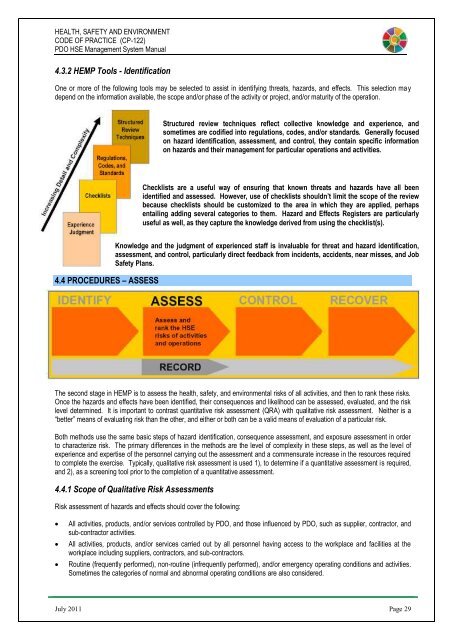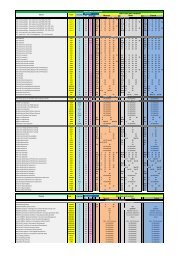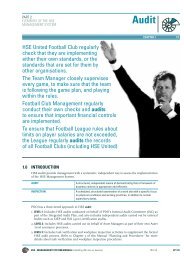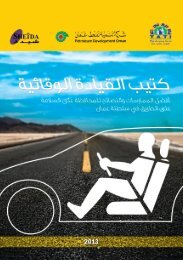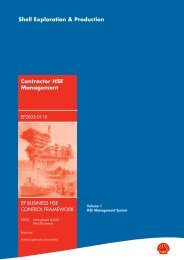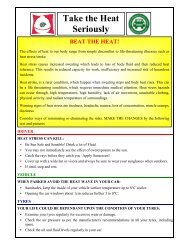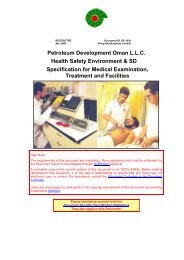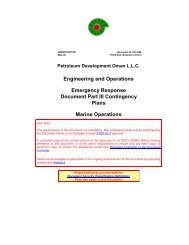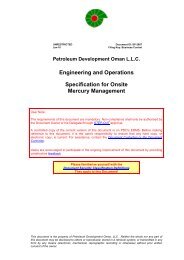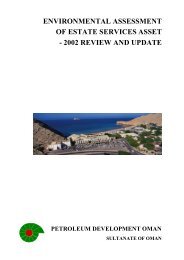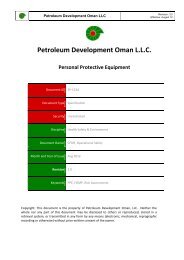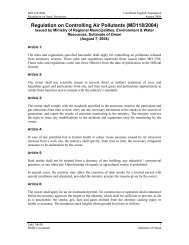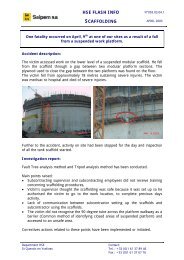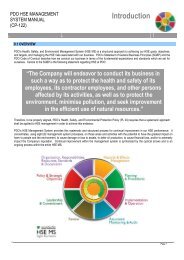CP-122 HSE Code of Practice - PDO
CP-122 HSE Code of Practice - PDO
CP-122 HSE Code of Practice - PDO
You also want an ePaper? Increase the reach of your titles
YUMPU automatically turns print PDFs into web optimized ePapers that Google loves.
HEALTH, SAFETY AND ENVIRONMENT<br />
CODE OF PRACTICE (<strong>CP</strong>-<strong>122</strong>)<br />
<strong>PDO</strong> <strong>HSE</strong> Management System Manual<br />
4.3.2 HEMP Tools - Identification<br />
One or more <strong>of</strong> the following tools may be selected to assist in identifying threats, hazards, and effects. This selection ma y<br />
depend on the information available, the scope and/or phase <strong>of</strong> the activity or project, and/or maturity <strong>of</strong> the operation.<br />
Structured review techniques reflect collective knowledge and experience, and<br />
sometimes are codified into regulations, codes, and/or standards. Generally focused<br />
on hazard identification, assessment, and control, they contain specific information<br />
on hazards and their management for particular operations and activities.<br />
Checklists are a useful way <strong>of</strong> ensuring that known threats and hazards have all been<br />
identified and assessed. However, use <strong>of</strong> checklists shouldn‟t limit the scope <strong>of</strong> the review<br />
because checklists should be customized to the area in which they are applied, perhaps<br />
entailing adding several categories to them. Hazard and Effects Registers are particularly<br />
useful as well, as they capture the knowledge derived from using the checklist(s).<br />
4.4 PROCEDURES – ASSESS<br />
Knowledge and the judgment <strong>of</strong> experienced staff is invaluable for threat and hazard identification,<br />
assessment, and control, particularly direct feedback from incidents, accidents, near misses, and Job<br />
Safety Plans.<br />
The second stage in HEMP is to assess the health, safety, and environmental risks <strong>of</strong> all activities, and then to rank these risks.<br />
Once the hazards and effects have been identified, their consequences and likelihood can be assessed, evaluated, and the risk<br />
level determined. It is important to contrast quantitative risk assessment (QRA) with qualitative risk assessment. Neither is a<br />
“better” means <strong>of</strong> evaluating risk than the other, and either or both can be a valid means <strong>of</strong> evaluation <strong>of</strong> a particular risk.<br />
Both methods use the same basic steps <strong>of</strong> hazard identification, consequence assessment, and exposure assessment in order<br />
to characterize risk. The primary differences in the methods are the level <strong>of</strong> complexity in these steps, as well as the level <strong>of</strong><br />
experience and expertise <strong>of</strong> the personnel carrying out the assessment and a commensurate increase in the resources required<br />
to complete the exercise. Typically, qualitative risk assessment is used 1), to determine if a quantitative assessment is required,<br />
and 2), as a screening tool prior to the completion <strong>of</strong> a quantitative assessment.<br />
4.4.1 Scope <strong>of</strong> Qualitative Risk Assessments<br />
Risk assessment <strong>of</strong> hazards and effects should cover the following:<br />
<br />
<br />
<br />
All activities, products, and/or services controlled by <strong>PDO</strong>, and those influenced by <strong>PDO</strong>, such as supplier, contractor, and<br />
sub-contractor activities.<br />
All activities, products, and/or services carried out by all personnel having access to the workplace and facilities at the<br />
workplace including suppliers, contractors, and sub-contractors.<br />
Routine (frequently performed), non-routine (infrequently performed), and/or emergency operating conditions and activities.<br />
Sometimes the categories <strong>of</strong> normal and abnormal operating conditions are also considered.<br />
July 2011 Page 29


